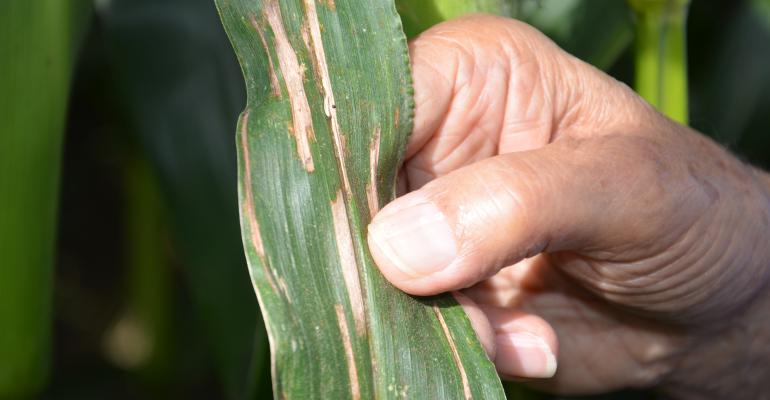Make most cost-effective fungicide decision

Corn Pest Beat: Scouting and timing will help fine-tune management decisions about fungicides on corn.
May 26, 2022
We’re seeing gray leaf spot on one hybrid about one-third the way up the plant. In a couple of fields, that hybrid is planted with another hybrid in 24-row blocks. Should we spray fungicide? Which one? When? Spray the whole field?
The Indiana certified crop adviser panelists answering this question include Betsy Bower, agronomist for Ceres Solutions, Lafayette; Greg Kneubuhler, G&K Concepts Inc., Harlan; Bryan Overstreet, Purdue Extension educator, Jasper County; and Dan Quinn, Purdue Extension corn specialist.
Bower: It sounds like lesions are still in the lower canopy on a hybrid susceptible to gray leaf spot. Once it infects the ear leaf two weeks before and/or after tassel, yield loss can occur.
If rain or heavy dews are in the forecast, gray leaf spot spores can move up the canopy. Dry conditions can limit movement of gray leaf spot.
So, what to do? Nearly all common corn fungicides are very effective at controlling gray leaf spot. Applying a fungicide before the infection gets started on ear leaves is key to protecting yield.
When to spray? The following are guidelines from Iowa State University. These recommendations incorporate hybrid susceptibility ratings and disease levels prior to tassel.
Consider a fungicide if: the hybrid rates as susceptible or moderately susceptible AND 50% of plants have disease lesions present on the third leaf below the ear leaf or higher prior to tasseling.
Consider a fungicide if: the hybrid rates as moderately resistant AND 50% of the plants have disease lesions present on the third leaf below the ear leaf or higher prior to tasseling AND additional factors or conditions that favor disease development are present. These include residue, favorable weather conditions and irrigation.
Kneubuhler: If you apply fungicides after you see leaf disease, the inoculum has already started, and damage has occurred. Response to fungicide is best achieved when it’s applied before leaf diseases begin. If that one hybrid showing gray leaf spot is planted in blocks with another hybrid, the other hybrid will more than likely exhibit it. Confer with your seed rep to confirm tolerance of those hybrids. Corn can handle a fair amount of gray leaf spot before yield losses occur. Northern corn leaf blight or tar spot are much more detrimental.
Overstreet: Spray this hybrid if over 50% of the plants show symptoms on the third leaf above the ear at tasseling. The best time to spray is at tasseling or shortly afterward. Use a strobilurin or a product with a fungicide in that class. Check the other hybrid to see if it’s needed when determining to spray the whole field
Quinn: If gray leaf spot is found in the lower canopy of the corn plant and is approaching the corn ear leaf prior to the plant reaching pollination or tasseling, a fungicide application is likely warranted at the VT/R1 growth stage. If your field has a history of gray leaf spot and the hybrid has low levels of gray leaf spot resistance, this can also help determine if a fungicide is needed.
Use the fungicide efficacy table put together by the Crop Protection Network to select products. This table shows which fungicides provide excellent control of gray leaf spot. The entire field should be sprayed. Spot-spraying fields for disease control isn’t recommended.

